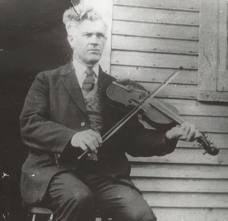Annotation:Quadrille de Beauharnois: Difference between revisions
No edit summary |
No edit summary |
||
| Line 2: | Line 2: | ||
{{TuneAnnotation | {{TuneAnnotation | ||
|f_tune_annotation_title= https://tunearch.org/wiki/Annotation:Quadrille_de_Beauharnois > | |f_tune_annotation_title= https://tunearch.org/wiki/Annotation:Quadrille_de_Beauharnois > | ||
|f_annotation='''QUADRILLE DE BEAUHARNOIS'''. AKA and see "[[Gigue des touristes (1)]]." French-Canadian, Jig or Quadrille. C Major. Standard tuning (fiddle). AABB. The jig if from the playing of Quebec fiddler Jospeh Allard (1873-1947), recorded for Victor in Montreal, Canada, in June, 1929. Allard re-recorded the tune in 1936, issued under the pseudonym "Maxime Toupin." The 'A' part of this melody resembles O'Neill's "[[Miss Blair’s Fancy]]," but there are not enough similarities to establish a direct association. Allard researcher Jean Duval also compares the tune Cape Breton composer Dan R. Macdonald's "[[Chanter Jig (The)]]." As per m. Duval's comment below, compare also with "[[Lasses of Limerick (2)]]," published by John Walsh in London in 1754 (or 1756 -- dates vary). The first strains of the tunes are quite similar. The second strains are somewhat less so, although there are some identical three-note sequences, | |f_annotation='''QUADRILLE DE BEAUHARNOIS'''. AKA and see "[[Gigue des touristes (1)]]." French-Canadian, Jig or Quadrille. C Major. Standard tuning (fiddle). AABB. The jig if from the playing of Quebec fiddler Jospeh Allard (1873-1947), recorded for Victor in Montreal, Canada, in June, 1929. Allard re-recorded the tune in 1936, issued under the pseudonym "Maxime Toupin." The 'A' part of this melody resembles O'Neill's "[[Miss Blair’s Fancy]]," but there are not enough similarities to establish a direct association. Allard researcher Jean Duval also compares the tune Cape Breton composer Dan R. Macdonald's "[[Chanter Jig (The)]]." As per m. Duval's comment below, compare also with "[[Lasses of Limerick (2)]]," published by John Walsh in London in 1754 (or 1756 -- dates vary). The first strains of the tunes are quite similar. The second strains are somewhat less so, and although there are some identical three-note sequences, the harmonic structure varies some | ||
[[File:allard.jpg|300px|thumb|left|Joseph Allard]] | [[File:allard.jpg|300px|thumb|left|Joseph Allard]] | ||
<br> | <br> | ||
Revision as of 20:40, 27 February 2023
X:1 T:Gigue des Touristes T:Quadrille de Beauharnois C:Joseph Allard M:6/8 L:1/8 Z:Bruce Osborne K:C e|"C"gec cBc|"G7"dBG G2 F|"C"EFG "Am"ABc|"D7"edc "G"d2 g|! "C"gec cBc|"G7"dBG G2 F|"C"EFG "F"ABc|"G7"dcB "C"c2:|! |:e|"C"gec c2 a|"F"age "C/E"c2 e|"C"gec cBc|"G7"dBG G2 g|! "C"gec c2 a|"F"age "C/E"c2 e|"C"gec "G7"BAB|"C"c3 -c2:|!
QUADRILLE DE BEAUHARNOIS. AKA and see "Gigue des touristes (1)." French-Canadian, Jig or Quadrille. C Major. Standard tuning (fiddle). AABB. The jig if from the playing of Quebec fiddler Jospeh Allard (1873-1947), recorded for Victor in Montreal, Canada, in June, 1929. Allard re-recorded the tune in 1936, issued under the pseudonym "Maxime Toupin." The 'A' part of this melody resembles O'Neill's "Miss Blair’s Fancy," but there are not enough similarities to establish a direct association. Allard researcher Jean Duval also compares the tune Cape Breton composer Dan R. Macdonald's "Chanter Jig (The)." As per m. Duval's comment below, compare also with "Lasses of Limerick (2)," published by John Walsh in London in 1754 (or 1756 -- dates vary). The first strains of the tunes are quite similar. The second strains are somewhat less so, and although there are some identical three-note sequences, the harmonic structure varies some

Beauharnois [1] is a town in Quebec, now within the Greater Montreal area.

